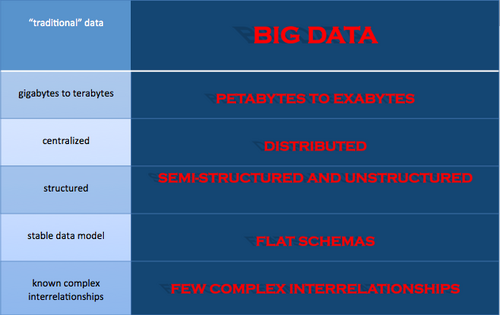 Wikibon, Nov 08, 2012, Originating Author: Jeff Kelly,
Wikibon, Nov 08, 2012, Originating Author: Jeff Kelly,
A Big Data Manifesto from the Wikibon Community
... Underlying every business analytics practice is data. Traditionally, this meant structured data created and stored by enterprises themselves, such as customer data housed in CRM applications, operational data stored in ERP systems or financial data tallied in accounting databases. But the volume and type of data now available to enterprises - and the need to analyze it in near-real time for maximum business value - is growing rapidly thanks to the popularity of social media and networking services like Facebook and Twitter, data-generating sensored and networked devices, both machine- and human-generated online transactions, and other sources of unstructured and semi-structured data. We call this Big Data.
Traditional data management and business analytics tools and technologies are straining under the added weight of Big Data and new approaches are emerging to help enterprises gain actionable insights from Big Data. These new approaches - namely an open source framework called Hadoop, NoSQL databases such as Cassandra and Accumulo, and Next Generation Data Warehouses from vendors like EMC Greenplum, HP Vertica, and Teradata Aster Data - take a radically different approach to data processing, analytics and applications than traditional tools and technologies. This means enterprises likewise need to radically rethink the way they approach business analytics both from a technological and cultural perspective. ...
The Changing Nature of Big Data
The advent of the Web, mobile devices and other technologies has caused a fundamental change to the nature of data. Big Data has important, distinct qualities that differentiate it from "traditional" corporate data. No longer centralized, highly structured and easily manageable, now more than ever data is highly distributed, loosely structured (if structured at all), and increasingly large in volume.
- Volume - The amount of data created both inside corporations and outside the firewall via the web, mobile devices, IT infrastructure, and other sources is increasing exponentially each year.
- Type - The variety of data types is increasing, namely unstructured text-based data and semi-structured data like social media data, location-based data, and log-file data.
- Speed - The speed at which new data is being created - and the need for real-time analytics to derive business value from it -- is increasing thanks to digitization of transactions, mobile computing and the sheer number of internet and mobile device users.
- Social Networking and Media: There are currently over 700 million Facebook users, 250 million Twitter users and 156 million public blogs. Each Facebook update, Tweet, blog post and comment creates multiple new data points, both structured, semi-structured and unstructured, sometimes called Data Exhaust.
- Mobile Devices: There are over 5 billion mobile phones in use worldwide. Each call, text and instant message is logged as data. Mobile devices, particularly smart phones and tablets, also make it easier to use social media and use other data-generating applications. Mobile devices also collect and transmit location data.
- Internet Transactions: Billions of online purchases, stock trades and other transactions happen every day, including countless automated transactions. Each creates a number of data points collected by retailers, banks, credit cards, credit agencies and others.
- Networked Devices and Sensors: Electronic devices of all sorts - including servers and other IT hardware, smart energy meters and temperature sensors -- all create semi-structured log data that record every action.

Read more.
| Next post |
